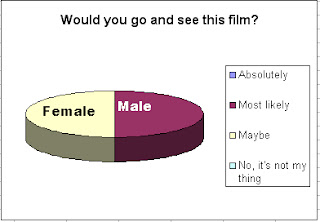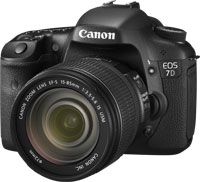I had a two-staged approach to audience feedback. Firstly I screened some early footage of our trailer to the class. The students in my class gave me some feedback on different aspects of my trailer. The majority of the class thought that my early footage clips weren't suitable for the horror genre as they were filmed in the light. However they thought that my setting in a field with windy, slightly rainy weather was good. Most students thought that the Mise en Scene was over-all good. My main character at this point was a girl, with pale make-up on and a white dress. From the audience's feedback I gathered that they thought this was a good start and that my character could develop immensely if the right setting was put together accordingly, although they did think that a male character would fit better for being the "evil" character in a horror. I took this idea into account and started to develop my ideas. The class thought my storyline was ok and could be developed to become much more horror genre-like, but as this was early days I took this as constructive criticism. On the whole, the class thought my starting plan was a good one but wasn't great. This didn't come as a shock to me as I was a complete beginner in film making and took all of their feedback into consideration and decided to change my plan completely and to change the story into one I thought would fit the horror genre and please the audience much more than my original idea. My main "evil" character changed to a man around the age of 35 and I introduced another character which would be the "victim", a young girl. The setting changed to a dark, eerie alleyway and then the trailer would continue on into the house of the victim. This first screening really helped me to see what the audience wanted from a horror trailer and facilitated the development of my narrative and characterization. Even though my feedback wasn't postive, short-term wise, the impact was positive long-term as it gave me a chance to re-think my ideas and come up with better ones.
Completed trailer screening
When I felt I had completed the trailer, I showed it to another audience. 4 people to be exact, 2 of which were in the age slot of our target audience, and 2 of which weren't. I expected their reactions to be very different to one anothers as the age difference has an impact on how you take in certain media texts, especially a horror film trailer as it depends very much on what the audience finds scary. I gave them each a questionnaire to fill out when they had watched the screening. (Questionnaire is on the blog) This questionnaire wasn't only to find out if my trailer was a success, it was to find out if my target audience in particular, decoded a preffered reading to my main media text and I had suceeded at my job as an encoder too. This feedback also helped me to find correlations between social stratification and reaction to the trailer.
The results were fantastic, my target audience feedback came out mostly preferred with my non target audience feedback coming back mostly aberrant. This was expected and helped me to see that I had succeeded in creating a trailer for a particular audience.
People react to media texts in different and sometimes unpredictable ways. I made sure my final trailer screening was done in a darkened room so that my trailer could be watched with full effect. However, if the trailer was watched in a different condition it may change the typical gratification a person might get from watching the video. Sometimes, giving your audience a questionnaire to do before a screening can cause them to feel differently about it and cause their original thoughts of the trailer to change without them noticing. I took this into account and gave my audience the questionnaire after they had watched the trailer. This ensured their original readings of my media texts weren't interferred with and the feedback I gained was completely accurate.
Overall, audience feedback, particularly the early screening, helped me to form my ideas and helped me to develop my trailer so it was of a standard which was accepted and thought of as good by my target audience. In a way, audience feedback helped me to create my trailer as it initiated the change of plan.
Final trailer screening 1 - non target audience
I devised a small questionnaire and showed my final film trailer to two people, one male and one female, both of which are over the age of 40. Now since this age is not one of our target audience I hope to see a slight difference in the answers given when compared to the answers given by the people I give it to who are in our target audience age slot.
Questionnaire:
Do you think the effects we have applied to the clips are effective?
Very effective 1 2 3 4 Not effective
Do you think the music fits in well with the scenes?
Fits very well 1 2 3 4 Doesn't fit
Do you think the ending of the trailer is effective?
Very effective 1 2 3 4 Not effective
Would you go and see this film?
Absolutely 1 2 3 4 No, it's not my thing
What age certificate do you think this film has?
U(universal) PG(parental guidance) 12A(12 with adult) 15(over 15) 18(over 18)
These were the outcomes, remembering this showing was to an audience which was way out of our target audience area:
Final trailer screening 2- target audience
I devised a small questionnaire and showed my final film trailer to two people, one male and one female, both of which are aged 18. Now since this age is one of our target audience I hope to see a slight difference in the answers given when compared to the answers given by the people I give it to who are not in our target audience age slot.
Questionnaire:
Do you think the effects we have applied to the clips are effective?
Very effective 1 2 3 4 Not effective
Do you think the music fits in well with the scenes?
Fits very well 1 2 3 4 Doesn't fit
Do you think the ending of the trailer is effective?
Very effective 1 2 3 4 Not effective
Would you go and see this film?
Absolutely 1 2 3 4 No, it's not my thing
What age certificate do you think this film has?
U(universal) PG(parental guidance) 12A(12 with adult) 15(over 15) 18(over 18)
These were the outcomes:























 This was expected as the clips are very simple at this time!
This was expected as the clips are very simple at this time!